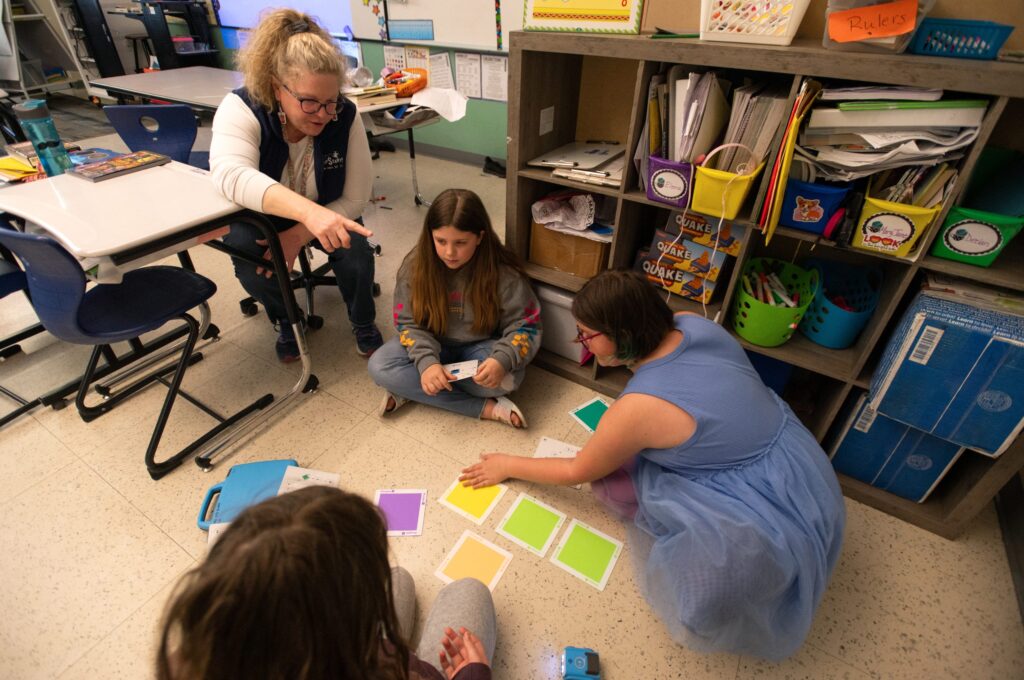A new project aims to transform 12 school districts in Maine into regional computer science hubs and train neighboring school districts on how to prepare students for the modern workforce.
The Maine Mathematics and Science Alliance receives an $8.2 million grant from the Harold Alfond Foundation and aims to train approximately 1,000 educators and reach 20,000 students across the state over the next five years . Some teachers tour companies that rely on computer science and find ways to integrate the field with classroom instruction. These could include activities where elementary school students learn the basics of algorithms or program motorized Lego blocks.
The Augusta-based nonprofit expects regionally based officials to train 30 districts over the next five years.
The STEM Workforce Ready project builds on Maine's efforts to expand computer science education across grade levels, including more than 1,000 students in coding, robotics, and other subjects starting in mid-2022. This includes sending mobile labs to 166 districts. As more industries rely on technology, students need to develop relevant skills to contribute to the workforce, said Ruth Kermish Allen, executive director of the Maine Mathematics and Science Alliance.
“We are trying to better understand what the future STEM workforce in rural Maine will look like and the types of skills needed for those roles,” she said.
The project isn't about bringing more computers into rural schools, she said, but rather about leveraging technology to make learning more engaging for the modern workforce. Ta. This prepares students for jobs ranging from engineering at Texas Instruments to operating a sawmill at Hammond Lumber Company.
Jennifer Trowbridge, who teaches fourth grade at Ellsworth Elementary and Middle School, is one of the educators experimenting with ways to incorporate more computer science into her daily lessons. Her students are particularly drawn to Sphero indi, a robotic toy car that teaches students how to give instructions to a computer using colored tiles. They are tasked with telling the car to speed up or slow down, travel a certain distance, or drive around a table.

Ms. Trowbridge is excited to see her students use different tools because they are motivated to find answers, rather than intimidated by challenges, even when the problems are difficult to solve. I like seeing them there. It's a skill they'll need as they move through life, she said, and it's important to develop it early on.
“One of the biggest benefits of doing this is that kids can become problem solvers,” she said. “Instead of just asking the computer to solve your problem, think about how you can use your computer to help solve your problem.”
Carmish Allen said the Bar Harbor eighth-graders built a 3D mitochondrial cell out of Styrofoam and programmed different parts to light up as ribosomes move through the cell. At Bethel, kindergarten classes were given graph paper with various letters drawn on it. We had to show how the money bags would reach each character by drawing arrows pointing up, down, left and right. This was a simplified way of writing the algorithm.
Companies aren't necessarily looking for young people who are coding experts, but they are looking for people who can think critically, problem solve and collaborate, and these activities are designed to do that, he said. Stated.
Maine Mathematics and Science Allianc's work on this project began before the COVID-19 pandemic. The organization received a small grant from the National Science Foundation to study how computer science is popularized in rural schools in Maine. STEM or computer science specifics tend to be limited.

The state's urban areas, such as Bangor and Portland, have larger tax bases and financial resources, providing more opportunities for students. But some rural areas lack access to computer science in classrooms, Carmish-Allen said.
“This was a topic that other states were working on, but there was minimal research and understanding in Maine,” Carmish Allen said. “We knew we needed to find a way to integrate computer science into our existing curriculum.”
In 2021, the organization used a $1 million grant from the Harold Alfond Foundation to work on solutions. Approximately 40 teachers met in person or virtually to explore how schools across the country are incorporating computer science into their curriculum. They then began designing and testing their own lessons for students in pre-K through 8th grade.
The program, which launches this summer, will expand those efforts by training more teachers and involving high school students. Fifty lead educators will be responsible for educating 1,000 others over the next five years.
Seven school districts – Bethel, Ellsworth, Lincoln, Mount Desert Island, Rangeley, Rumford and Turner – are committed to becoming regional hubs for training in two to three nearby school districts in the long term.
Educators will network, share ideas and participate in workshops during the CS Summer of Fun event from July 29 to August 2 at the University of Maine in Orono. The Maine Mathematics and Science Alliance and Portland-based Educate Maine are hosting Professional Development Week.
Educate Maine is also organizing trips for teachers to visit employers across the state, which is expected to begin in October. They tour the facility and hear from leaders about the qualities and skills they look for when hiring. Angela Oxley, program director at Educate Maine, said some teachers are placed with companies for two-week internships, where they observe employees and find ways to apply what they learn in the classroom. It is said that there is.
Having computer science available in K-12 classrooms “levels the playing field for students, increases their confidence and gives them a path to good jobs in Maine,” she said. .
As the project evolves, the idea is to make lesson plans that work at Ellsworth available to Presque Isle teachers so no one has to reinvent the wheel, Carmish Allen said. Masu.
“We hope this project is the first step in what will be a larger effort for reform across the state,” she said. “We see this increasing over time.”


